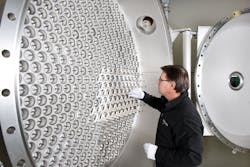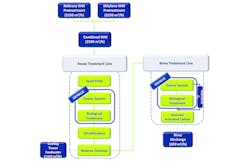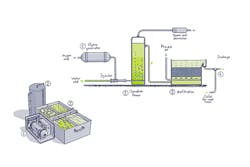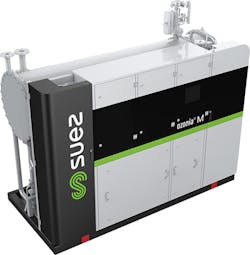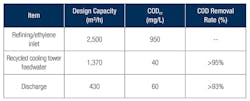Ozone-based treatment for refinery and petrochemical wastewater
Water is the liquid gold that drives the trajectory of all industry. In oil and gas — the third largest consumer of water behind agriculture and power generation — water is a key cost in upstream and downstream operations. Much of that cost is related to addressing the chemical substances found in refinery wastewater and petrochemical operations. These difficult-to-degrade compounds can negatively affect the performance of the facility’s wastewater treatment plant, leading to possible discharge permit violations and other regulatory issues.
Oil and gas managers are exploring new technologies and outside-the-box methods to address the treatment of these organic and inorganic compounds while simultaneously reducing and reusing water. By unlocking the power of water, industrial wastewater plants can transform from disposal facilities to resource recovery centers and monetize their wastewater streams.
In China, water sustainability has been an increasing focus since the country’s 11th Five-Year Plan in 2006 that set out to reduce water and energy consumption, promote the utilization rate of recycled water, and establish screening and evaluation methods for water consumption within industrial projects.1
Goals for refinery and petrochemical wastewater
In 2009, PetroChina announced plans to build a refinery and petrochemical facility outside the city of Chengdu in China’s Sichuan province. The Sichuan Petro facility can produce up to 10 million tons per year (240 kbpd) of crude oil and 800,000 tons per year of ethylene. PetroChina commissioned SUEZ to design, build and commission a comprehensive wastewater and recycling treatment plant to support the facility and fall in line with the five-year plan.
With a maximum capacity of 2,500 m3/h, the system needed to treat two streams of effluents: 50 percent from the refinery’s oil-based stream and 50 percent from the ethylene’s salt-based stream. The challenging nature of the combined effluent was compounded by PetroChina’s aggressive water goals for the entire facility, which included:
- Reuse up to 70 percent of the wastewater effluent for cooling tower feedwater at maximum capacity
- Meet the maximum discharge flow rate of less than 430 m3/h
- Bring the plant’s industrial effluent in compliance with demanding chemical oxygen demand (COD) discharge standards of 60 mg/L
A solution to stabilize industrial water usage
To reach PetroChina’s targets for COD removal and wastewater reuse, a comprehensive, integrated design approach included the creation of a unique system (see Figure 1). It begins with a wastewater pretreatment process, including primary and secondary oil removal, nitrification and denitrification biological treatment, secondary clarification and lamellar clarification for polishing.
Next, the effluents are combined and enter the reuse treatment line, which begins with a SUEZ gravity sand filter followed by two water treatment processes: ozone oxidation and biological aerated flooded filters (BAFF), a combination that comprises SUEZ’s Oxyblue process.
Figure 1. Sichuan Petro’s wastewater treatment system
With refinery and petrochemical facilities experiencing an increase in complex organic and inorganic chemicals, refinery wastewater treatment is requiring more than conventional biological methods. Long considered a best-in-class technology in the municipal drinking water sector, ozone-based treatment processes are now being heralded for their technological advantages in wastewater, reuse and recycling. Ozone and advanced oxidation processes (AOPs), which combine ozone with another oxidant such as hydrogen peroxide (H2O2), effectively oxidize a variety of compounds. While ozone is more than 50 percent stronger than chlorine, AOPs provide almost 40 percent higher oxidation potential and up to 30 percent faster reaction times.
“AOPs provide almost 40 percent higher oxidation potential and up to 30 percent faster reaction times.”
Ozone oxidation technologies are flexible in their implementation; they can be used in a variety of ways within a treatment plant to improve overall plant performance and reduce expenses. A single ozone system can be used in a multi-injection point scheme for pretreatment, intermediate oxidation and polishing to improve efficiency, lower ozone doses, and reduce total ozone consumption and energy use. Ozonation in this particular system is used in three places to remove COD, ferrous iron (Fe2+) and manganese (Mn2+) and to improve downstream filter performance.
The process designed for PetroChina consists of three stages (see Figure 2):
Figure 2. The three-stage process eliminates nonbiodegradable organic pollutants in wastewater.
Stage 1: Ozone generation — Pure oxygen gas is supplied to an ozone generator to produce ozone. At Sichuan Petro, two SUEZ ozone generators with a total capacity of 200 kg O3/h provide ozone for three injection points within the plant: one in the reuse treatment line, one in the brine treatment line, and a third in the reuse line after the biological treatment for additional COD removal if required.
Stage 2: Ozonation — The effluent is directed to an ozonation dissolution tower where the ozone gas is dissolved into the effluent. The oxidative power of ozone renders residual organic matter biodegradable by converting COD to BOD and oxidizing humic substances, micropollutants and other compounds.
Stage 3: Biological filtration — The final stage in the process eliminates pollutants in a compact biological aerated flooded filtration system. This technique permits the water leaving the tower to pass through a filter where bacteria, fixed on clay beads, eliminates carbon and nitrogen compounds present in the water. The combination of these two techniques boosts the degradation process of residual organic matter.
Industrial-scale ozone generation systems include several components: an ozone generation reactor, electrical power supply unit, piping and advanced monitoring and automation systems.
Ozone pretreatment followed by biologically active filtration is an advanced wastewater treatment technique that provides a cost-effective solution for recalcitrant COD and micropollutant removal. At Sichuan Petro, the process concludes with two additional steps: ultrafiltration (UF) and reverse osmosis (RO). On average, the reuse treatment line recycles 70 percent of the RO permeate water to serve as cooling tower feedwater. This recycling scheme meets China’s strict requirements for reuse and has a COD of 40 mg/L, a COD removal rate of more than 95 percent. In operation, Sichuan Petro reuses 65 percent, or 6.8 billion liters, of water per year, reducing stress on the region’s natural resources and driving down costs by drastically cutting water consumption.
“Sichuan Petro reuses 65 percent, or 6.8 billion liters, of water per year, reducing stress on the region’s natural resources and driving down costs by drastically cutting water consumption.”
Results and further treatment of refinery and petrochemical wastewater
The RO reject is fed to the brine treatment line where it undergoes hard COD removal using Oxyblue and granular activated carbon (GAC) filtration. This process again harnesses the combined efficiency of ozone and biological filtration technology, but this time, it achieves the target discharge standards of 430 m3/h with 60 mg/L COD. The final treated effluent is discharged into the Tuo River via a natural reserve area.
Table 1. COD removal rates
AOPs are an emerging technology for the treatment of industrial refinery and petrochemical wastewater containing refractory organic compounds. Many variations of AOPs can be applied in chemical, photochemical or electrochemical processes. These processes are effective at removing organic compounds and reducing or eliminating sludge in industrial applications.
From effluent laboratory analysis and piloting to system design and operation, a full scope of technologies for water reuse and removal of hard COD allows for a customized approach in treating organic substances. An integrated and comprehensive solution is needed for industrial wastewater treatment and resource recovery.
REFERENCES
- Beijing’s 11th Five-Year Plan Outline. Beijing Association of Enterprises with Foreign Investment. March 2006.
www.mwcog.org/asset.aspx?id=committee-documents/sfpxvly20060405143955.pdf.
Christopher Huynh is the market manager for the ozone product line for SUEZ – Water Technologies and Solutions. He has contributed to the product and system evolution of SUEZ’s ozone, UV and advanced oxidation industrial and municipal water treatment solution portfolio. Huynh can be contacted at [email protected].
Yibin Weng, Ph.D., is an engineer at the State Key Laboratory of Petroleum Pollution Control, CNPC Research Institute of Safety and Environmental Technology in Beijing. He can be contacted at [email protected].
